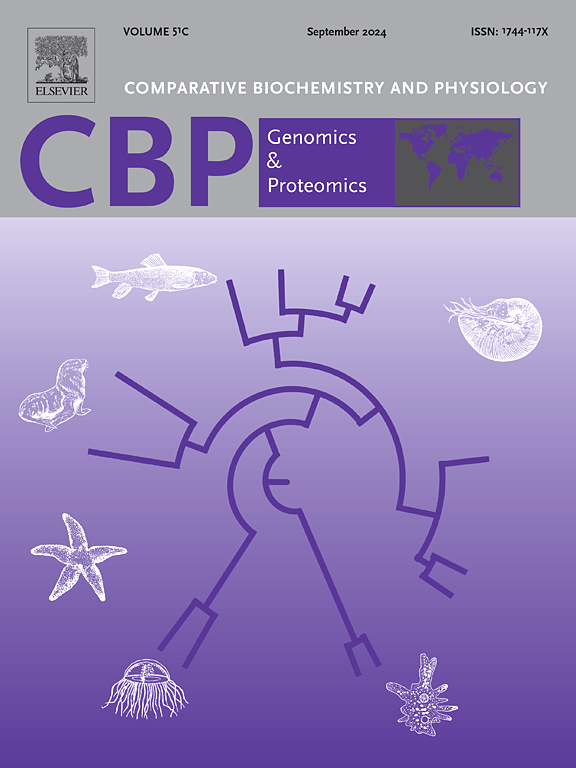转录组来源的证据揭示了快速生长的mstnb-/-雄性罗非鱼骨骼肌中的调控网络。
IF 2.2
2区 生物学
Q4 BIOCHEMISTRY & MOLECULAR BIOLOGY
Comparative Biochemistry and Physiology D-Genomics & Proteomics
Pub Date : 2024-12-23
DOI:10.1016/j.cbd.2024.101405
引用次数: 0
摘要
肌生长抑制素(Mstn)负向调节肌肉生长,Mstn缺乏诱导包括罗非鱼在内的脊椎动物的“双骨骼肌”发育。在这项研究中,我们对野生型和mstnb-/-雄性的骨骼肌进行了转录组学分析,以研究mstnb-/-突变体骨骼肌肥大的分子机制。我们鉴定了4697个差异表达基因(DEGs), 113个差异表达的长链非编码rna (DE lncRNAs), 211个差异表达的环状rna (DE circRNAs)和98个差异表达的microRNAs (DE miRNAs)。deg在蛋白酶体和泛素介导的蛋白水解途径中显著富集。DE lncrna的顺式和反式靶向基因在上述两条通路中也显著富集。DE环状rna的假定宿主基因与肌原纤维、收缩纤维等相连。此外,DE mirna与泛素介导的蛋白水解和关键信号通路相关,包括AMPK、FoxO和mTOR。此外,构建了核心竞争内源RNA (ceRNA)网络,包括31个DEGs, 37个DE mirna, 14个DE circrna和45个DE lncrna。强调了泛素-蛋白酶体系统在ceRNA网络中的关键作用。综上所述,本研究为Mstn突变体通过抑制蛋白质降解来增加肌肉质量提供了一个新的视角,并有助于我们理解鱼类骨骼肌肥大的分子机制。本文章由计算机程序翻译,如有差异,请以英文原文为准。

Transcriptome-derived evidence reveals the regulatory network in the skeletal muscle of the fast-growth mstnb−/− male tilapia
Myostatin (Mstn) negatively regulates muscle growth and Mstn deficiency induced “double-skeletal muscle” development in vertebrates, including tilapias. In this study, we performed a transcriptomic analysis of skeletal muscle from both wild-type and mstnb−/− males to investigate the molecular mechanisms underlying skeletal muscle hypertrophy in mstnb−/− mutants. We identified 4697 differentially expressed genes (DEGs), 113 differentially expressed long non-coding RNAs (DE lncRNAs), 211 differentially expressed circular RNAs (DE circRNAs), and 98 differentially expressed microRNAs (DE miRNAs). The DEGs were significantly enriched in proteasome and ubiquitin-mediated proteolysis pathways. Cis- and trans-targeting genes of DE lncRNAs were also notably enriched in the above two pathways. The putative host genes of DE circRNAs linked to myofibrils, contractile fibers, and so on. Additionally, DE miRNAs were associated with ubiquitin-mediated proteolysis and key signaling pathways, including AMPK, FoxO, and mTOR. Furthermore, the core competing endogenous RNA (ceRNA) network was constructed comprising 31 DEGs, 37 DE miRNAs, 14 DE circRNAs, and 45 DE lncRNAs. The key roles of ubiquitin-proteasome system were highlighted in the ceRNA network. Taken together, this study provides a novel perspective on muscle mass increase in Mstn mutants through the repression of protein degradation and facilitates our understanding of the molecular mechanisms of skeletal muscle hypertrophy in fish.
求助全文
通过发布文献求助,成功后即可免费获取论文全文。
去求助
来源期刊
CiteScore
5.10
自引率
3.30%
发文量
69
审稿时长
33 days
期刊介绍:
Comparative Biochemistry & Physiology (CBP) publishes papers in comparative, environmental and evolutionary physiology.
Part D: Genomics and Proteomics (CBPD), focuses on “omics” approaches to physiology, including comparative and functional genomics, metagenomics, transcriptomics, proteomics, metabolomics, and lipidomics. Most studies employ “omics” and/or system biology to test specific hypotheses about molecular and biochemical mechanisms underlying physiological responses to the environment. We encourage papers that address fundamental questions in comparative physiology and biochemistry rather than studies with a focus that is purely technical, methodological or descriptive in nature.

 求助内容:
求助内容: 应助结果提醒方式:
应助结果提醒方式:


